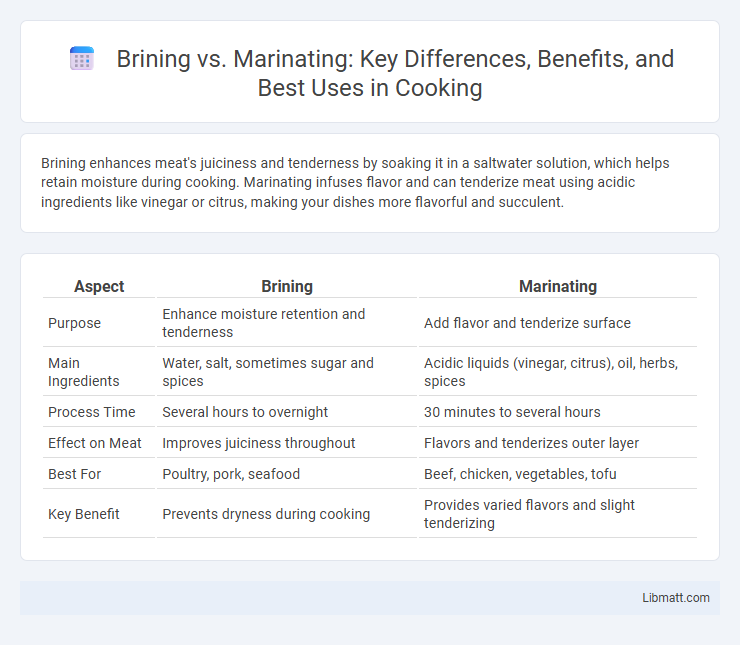Brining enhances meat's juiciness and tenderness by soaking it in a saltwater solution, which helps retain moisture during cooking. Marinating infuses flavor and can tenderize meat using acidic ingredients like vinegar or citrus, making your dishes more flavorful and succulent.
Table of Comparison
| Aspect | Brining | Marinating |
|---|---|---|
| Purpose | Enhance moisture retention and tenderness | Add flavor and tenderize surface |
| Main Ingredients | Water, salt, sometimes sugar and spices | Acidic liquids (vinegar, citrus), oil, herbs, spices |
| Process Time | Several hours to overnight | 30 minutes to several hours |
| Effect on Meat | Improves juiciness throughout | Flavors and tenderizes outer layer |
| Best For | Poultry, pork, seafood | Beef, chicken, vegetables, tofu |
| Key Benefit | Prevents dryness during cooking | Provides varied flavors and slight tenderizing |
Understanding Brining: Definition and Process
Brining involves soaking meat in a saltwater solution to enhance moisture retention and tenderness during cooking. The process allows salt to penetrate the meat, breaking down muscle fibers and improving flavor absorption. Understanding how brining works can help you achieve juicier and more flavorful dishes compared to marinating.
What is Marinating? Key Concepts Explained
Marinating involves soaking food, typically meat, in a seasoned liquid mixture containing acids like vinegar, citrus juice, or wine, combined with herbs, spices, and oils to enhance flavor and tenderness. The acid in the marinade breaks down muscle fibers, allowing deeper flavor penetration and a juicier texture during cooking. Key concepts include the importance of marination time, the balance of acidic and flavorful ingredients, and ensuring food safety by refrigerating during the marinating process.
Purpose: Why Use Brining or Marinating?
Brining enhances moisture retention and flavor penetration by submerging meat in a saltwater solution, making it juicier and tender during cooking. Marinating infuses food with acidic or enzymatic ingredients like vinegar, citrus, or yogurt to tenderize proteins and impart distinct flavors. Both techniques improve texture and taste, but brining focuses primarily on moisture enhancement while marinating emphasizes flavor complexity and protein breakdown.
Key Ingredients in Brines and Marinades
Brines primarily consist of water, salt, sugar, and sometimes herbs or spices, designed to enhance moisture retention and flavor through osmotic pressure. Marinades include acidic components like vinegar, citrus juice, or wine, combined with oils, herbs, and spices to tenderize and infuse your meat with complex flavors. Understanding these key ingredients helps you choose the best method to achieve juicy, flavorful results in your cooking.
Science Behind Brining vs Marinating
Brining involves soaking meat in a saltwater solution, allowing the salt to penetrate the muscle fibers and enhance moisture retention, resulting in juicier and more tender meat. Marinating uses acidic ingredients like vinegar or citrus combined with herbs and spices, which chemically break down proteins to add flavor and tenderize. Understanding the science behind these methods helps you choose the best technique for your desired texture and taste in cooking.
Flavor Impact: How Each Method Affects Taste
Brining enhances the natural flavor of your meat by allowing salt and water to penetrate deeply, resulting in juicier, more tender cuts with subtly intensified taste. Marinating infuses your food with diverse flavor profiles from herbs, spices, acids, and oils, creating distinct and layered tastes depending on the ingredients used. Your choice between brining and marinating influences how flavor develops, either through moisture retention and salt absorption or through external seasoning and chemical tenderizing.
Texture Differences: Moisture and Tenderness
Brining involves soaking meat in a saltwater solution, which increases moisture retention and results in a juicier texture due to the salt proteins breaking down muscle fibers. Marinating typically uses acidic ingredients like vinegar or citrus, which tenderize by denaturing proteins but can sometimes make the texture softer or slightly mushy if overdone. The key difference is that brining enhances moisture and firmness, while marinating primarily affects surface tenderness and flavor absorption.
Best Foods for Brining vs Best Foods for Marinating
Brining is ideal for lean meats such as chicken breasts, turkey, and pork chops, as it helps retain moisture and enhance juiciness during cooking. Marinating works best with tougher cuts like flank steak, skirt steak, or vegetables, where acidic ingredients break down fibers and infuse flavor. Choosing brining or marinating depends on the texture and moisture needs of your food to achieve the best taste and tenderness.
Common Mistakes and How to Avoid Them
Overbrining meat can lead to an overly salty and mushy texture, while underbrining fails to enhance juiciness and flavor; ensuring brine concentration and timing match the meat type prevents this. Marinating with acidic ingredients for too long breaks down proteins excessively, causing a mealy surface, so limiting marinade duration based on ingredient strength is essential. Avoiding these common mistakes preserves optimal texture and taste, maximizing the benefits of both brining and marinating techniques.
Choosing the Right Method for Your Recipe
Brining involves soaking meat in a saltwater solution to enhance moisture and tenderness, making it ideal for poultry and pork dishes that require juiciness. Marinating uses acidic or enzymatic ingredients like vinegar, citrus juice, or yogurt to impart flavor and tenderize, perfect for beef, fish, or vegetables needing both taste infusion and texture improvement. Your choice between brining and marinating depends on the desired outcome: brining for moisture retention and marinating for flavor and tenderizing effects in your recipe.
Brining vs Marinating Infographic

 libmatt.com
libmatt.com